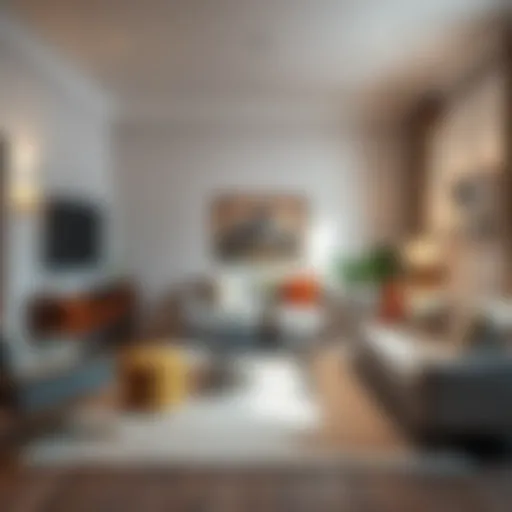Maximizing Comfort in Small One-Person Apartments
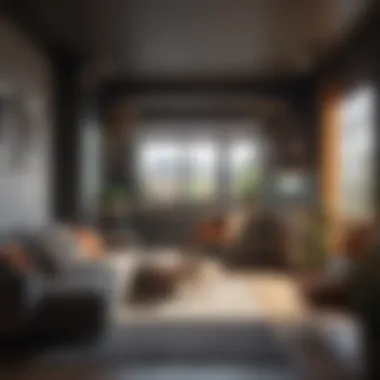

Intro
In an era where urban density continues to rise, many individuals find themselves navigating the challenges of living in small one-person apartments. These uniquely compact spaces demand a fresh perspective on design and functionality, offering both opportunities and obstacles. As solo living trends upward, the necessity for maximizing comfort and style within limited square footage has become paramount. This article aims to shed light on these dynamics, exploring how individuals can cultivate personal sanctuaries that reflect their identities while providing the conveniences of modern living.
Whether you're a seasoned city dweller or contemplating your first solo move, understanding the intricacies of small apartment life is essential. We will delve into space optimization techniques, contemporary interior design trends, and the psychological implications of solitary living within confined environments. Through thoughtful analysis, we aim to inspire a profound appreciation for minimalism and its transformative potential in personal spaces.
Feature Spotlight
Exceptional Architectural Designs
Small one-person apartments often highlight innovative architectural strategies aimed at overcoming space limitations. Architects are increasingly skilled at crafting living environments that blend functionality with aesthetics. Studio apartments in urban centers often feature open floor plans that connect essential areas – such as the kitchen and sitting room – into one fluid space. This encourages a sense of airiness, allowing natural light to pour in uninhibited.
Moreover, multi-functional furniture plays a crucial role within these designs. For instance, pieces that seamlessly transition from a dining table to a workstation or pull-out couches that transform a living space into a guest room are emerging as staples in compact apartments. This adaptability is vital for those navigating the duality of work and relaxation.
Unique Decor Elements
To truly personalize a small living space, incorporating unique decor elements can make all the difference. This could involve integrating bold colors, artistic accents, or textured materials that resonate with the personality of the dweller. A vivid piece of artwork can act as a focal point, creating a mood that sets the tone for the entire area.
Additionally, plants can breathe life into otherwise stark settings. Careful selection of indoor plants that thrive in low light can soften the atmosphere and improve air quality. Remember, details matter; even the choice of curtains or a quintessential coffee table book can reveal much about the individual’s tastes.
"Living alone doesn’t have to mean living small in style; it’s an opportunity to curate a space that’s wholly your own."
As we navigate through this article, we will discuss practical ways to blend these elements, demonstrating how thoughtful decicions can create not just a livable area but a personal retreat.
Understanding Small One-Person Apartments
In the world of urban living, the emergence of small one-person apartments has become increasingly significant. These spaces are more than just a roof over one's head; they encapsulate a lifestyle choice, a response to rising living costs, and shifting societal values. Understanding these apartments is crucial as they allow us to grasp how individuals adapt to their environment in an age where space often feels like a luxury.
The advantages of small apartments extend beyond mere functionality. For many, they provide a sense of independence and the opportunity to embrace minimalism. Additionally, these spaces generally incur lower utility and maintenance costs, making them appealing during tough economic times. Moreover, the design of small apartments often promotes creative solutions that make the most of limited space, helping occupants feel less cramped and more at home.
Further, there are various considerations one must take into account when evaluating small one-person apartments—such as location, layout, and access to amenities. For instance, the appeal of a central location can often outweigh the desire for more square footage. Conversely, the chance to reside in a quieter area could sway an individual’s preference despite a longer commute.
Defining the Concept
Small one-person apartments can be defined as compact living quarters designed to accommodate an individual comfortably. Typically ranging from 300 to 600 square feet, these apartments offer essential living spaces like a bedroom, kitchen, and bathroom, yet might do so in unconventional layouts or a blend of multi-purpose areas.
The beauty of these setups lies within their design: each square foot is accounted for, encouraging a lifestyle filled with intention and thoughtfulness. For many residents, these spaces foster a unique mental landscape that encourages organization, simplicity, and even admiration for personal belongings.
Historical Context
To appreciate the present state of one-person apartments, it's worth examining their historical context. The concept of living in a compact space is not new; it stretches back to the post-World War II era, where economic constraints led to the rise of urban apartment living. Throughout history, different cultures have adapted to space limitations—think of the tiny dwellings of ancient Rome or the bachelor pads of the 1950s.
Fast forward to today, and we see an increasing number of urban dwellers opting for these small living spaces. As cities grow denser and populations swell, the trend reflects changing attitudes towards ownership and lifestyle. Millennials and Gen Z are particularly drawn to smaller houses, seeking experiences and convenience over material possessions.
Global Trends in Solo Living
The trend toward solo living is being felt globally. In cities like Tokyo and New York, single-person households have been on the rise for decades. Urbanization, evolving gender roles, and increasing travel rates underpin this movement.
Here are some emerging global trends in solo living:
- Cohousing Arrangements: Many inhabitants of small apartments join communal living setups to mitigate loneliness. Shared spaces—like kitchens or gardens—offer social interaction without sacrificing privacy.
- Remote Work: The recent shift toward remote work has also influenced living situations. Many choose to prioritize a comfortable home office setup in a smaller living space, blending work and personal life.
- Rental Markets: In major cities, the rental market has adapted, providing diverse options for one-person apartments, ensuring an array of styles and price points.
"Small living isn't just a trend—it's a mission to reclaim space and emphasize what truly matters."
Understanding small one-person apartments is not merely about the physical space; it’s about the lifestyle they foster and the increasing number of individuals choosing to maximize their living experience in compact quarters. By dissecting the elements, historical context, and modern trends, we gain insight into a solution that challenges conventional living norms.
Space Optimization Techniques
When it comes to small one-person apartments, space optimization techniques are not just a luxury; they become a necessity. These strategies are crucial for turning a compact space into a functional and inviting sanctuary. In this section, we will explore techniques that make the most out of limited square footage, helping individuals lead comfortable lives without feeling cramped.
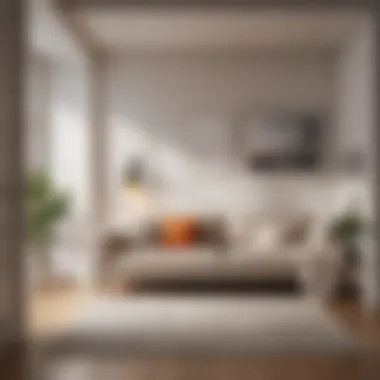

Furniture Selection and Arrangement
Choosing the right furniture is a delicate dance for anyone residing in a small apartment. This involves considering both function and aesthetics. Selecting pieces that serve dual purposes can be a real game changer. For instance, a sofa bed serves as both a cozy sitting area during the day and a guest bed at night. A dining table that can expand or collapse also offers flexibility without hogging precious real estate.
When it comes to arranging furniture, think vertically rather than horizontally. Instead of sprawling out, you can create an illusion of space by using wall-mounted shelves and floating cabinets. Doing this draws the eye upward and helps free up floor space. Moreover, consider open layouts that allow for fluid movement and visual connection within the apartment. Organizing furniture to create distinct zones—like a reading nook or a workspace—can also enhance functionality.
Storage Solutions for Compact Spaces
Storage in small apartments often feels like a game of Tetris. The aim is to fit as much as possible within limited walls and corners while maintaining a sense of order. Start by examining underutilized areas.
- Under the bed: Invest in storage bins or drawers to hold seasonal clothing or extra bedding.
- Over the door: Hooks or hanging organizers can store anything from cleaning supplies to accessories.
- Vertical spaces: Tall shelving units can make a striking statement while providing necessary storage.
Moreover, modular furniture can offer a plethora of options. Consider ottomans with storage or benches that can hold items inside while being used as extra seating. A little creativity in your storage solutions can transform clutter into organized charm.
Multifunctional Design Elements
The hallmark of effective space optimization in small apartments lies in the use of multifunctional design elements. Critically, it’s about solving problems that arise from limited spaces through clever design.
Incorporating elements like foldable tables, murphy beds, or even pull-out desks can breathe new life into tight quarters. Another idea is using rugs to delineate spaces—different areas can feel more complete while maintaining a cohesive vibe.
Even decor can serve a purpose beyond being just pretty. Art pieces that double as storage, like decorative boxes or shelves, can be both an aesthetic choice and a functional piece of furniture. Essentially, each piece should tell a story or fulfill a need without overwhelming the space.
"Optimal use of small spaces often leads to innovative solutions that not only enhance living conditions but also elevate the overall experience of solitude".
Interior Design Styles for Small Apartments
The concept of interior design styles plays a crucial role in shaping how we perceive and experience small one-person apartments. In a limited space, the choice of design not only dictates the aesthetics but also significantly impacts functionality and comfort. Properly selected styles can enhance the feeling of spaciousness, highlight purposeful features, and harmonize the overall environment, making it a sanctuary for its occupant.
When considering the interior design of such compact living spaces, it's beneficial to think beyond mere decoration. The selected style should resonate with the individual's personality, creating a welcoming atmosphere that encourages relaxation and creativity. Moreover, the right design approach can lead to efficient use of space, integrating the essential elements needed for daily living while maximizing the visual appeal. Here, we will explore three dominant styles that are particularly fitting for small apartments: minimalism, Scandinavian influence, and contemporary/eclectic approaches.
Minimalism: Embracing Simplicity
Minimalism, often characterized by a less-is-more philosophy, serves as a beacon for those navigating the cramped quarters of one-person apartments. This design style strips away the excess, favoring clean lines and uncluttered spaces. When applied effectively, minimalism fosters an atmosphere of tranquility. The focus shifts from numerous decorative elements to essential furniture and functionalities, making it suitable for small spaces.
A few notable benefits of minimalism include:
- Visual Clarity: By minimizing clutter, each piece of furniture stands out, allowing for clearer lines of sight that can make a space feel more open.
- Easier Maintenance: Fewer items mean less dusting and cleaning, significantly easing upkeep.
- Enhanced Mental Space: A simplified environment often translates to reduced stress, providing a calming retreat from chaos.
However, it's not just about removing items. To truly embrace minimalism, one must also be strategic in selecting high-quality materials and pieces that reflect personal style while adhering to the essence of the methodology.
Scandinavian Influence: Function Meets Aesthetics
Scandinavian design has gained recognition for its seamless blend of functionality and beauty. Originating from the Nordic countries, this style emphasizes light, airy spaces brimming with natural elements. In a one-person apartment, the high-engagement and thoughtful use of space is paramount, making Scandinavian aesthetics a wise choice.
Some key features to consider include:
- Neutral Color Palettes: Light colors promote an airy feel, making rooms look more spacious. Soft whites, light grays, and gentle pastels are staples.
- Natural Light: Large windows and open layouts optimize sunlight exposure, providing a warm ambiance.
- Functional Furniture: Pieces are designed not only to look good but also to be multi-functional, adding value without overcrowding the area.
With its emphasis on simplicity, cleanliness, and warmth, Scandinavian design can turn a small living space into a cozy, inviting home, encouraging occupants to take pride in their living arrangements.
Contemporary and Eclectic Approaches
Embracing a contemporary style allows for a flexible interpretation, merging modern trends with personal flair. The beauty of a contemporary approach is its adaptability to the individual tastes of its inhabitant, encouraging an eclectic mix of shapes, textures, and colors. For those who resist categorization, fusing styles can yield a dynamic and personal space.
Considerations include:
- Mixing Textures: Combining wood, metal, glass, and fabric adds depth and interest while cleverly utilizing vertical space, drawing the eye upwards.
- Bold Accents: Incorporate standout pieces—like brightly colored artworks or unique furniture—that can serve as conversation starters without overwhelming the space.
- Flexible Layouts: Arrange furniture to create distinct zones within the area— a reading nook, a workspace, or an entertainment sector, enabling the versatility needed in a one-person apartment.
This style embraces diversity, allowing each individual to reflect their own story through the curated selection of design elements.
Embracing various interior design styles can provide a solid foundation for cultivating small one-person apartments into functional and aesthetically pleasing spaces. Each style offers a unique avenue to make a compact area feel like home. By understanding the importance of style within these limitations, one can transform challenging environments into vibrant living spaces.
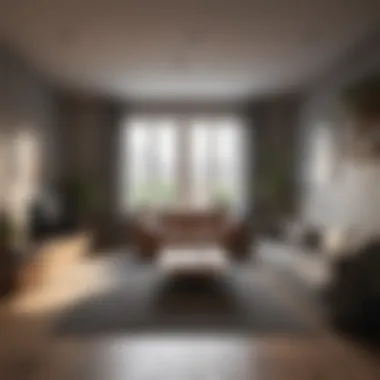

"Design is not just what it looks like and feels like. Design is how it works." - Steve Jobs
Emotional and Psychological Aspects of Living Solo
Living alone in a small apartment can conjure a myriad of emotions. The significance of understanding the emotional and psychological aspects of living solo extends far beyond mere comfort in a physical space. This thread runs through the fabric of individual experiences, connecting feelings of autonomy, identity, and even the sometimes-jarring contrast between solitude and loneliness. At their core, small one-person apartments offer a unique crucible for self-exploration, where every corner, every design choice reflects personal values and life stories.
The Psychology of Space
The environment we inhabit can deeply influence our mental state. In small one-person apartments, the layout and decor play a critical role in establishing a psychological ambiance. For instance, the choice of color scheme is not just an aesthetic decision; certain hues can evoke specific feelings.
- Warm colors like red or orange can create a sense of energy but might become overwhelming in a confined space.
- Cool colors, such as blues and greens, often induce calm and promote relaxation, which is crucial for a one-person setup where stress relief is essential.
Additionally, clutter can weigh heavily on the mind. Living in a smaller environment necessitates streamlined organization. This helps cultivate tranquility by eliminating visual chaos, fostering a sense of control amidst life's uncertainties.
"The granite weight of clutter is not just on the countertops; it weighs down the spirit."
Solitude vs. Loneliness in Small Spaces
Navigating the thin line between solitude and loneliness is fundamental in solo living. Solitude can be a friend, a space where one finds peace and creativity. However, when solitude morphs into loneliness, the emotional fallout can be stark.
- Solitude provides a backdrop for self-reflection, allowing individuals to engage in hobbies, read, or simply enjoy their own company without distractions. This reinvigorates the spirit and allows for personal growth.
- Loneliness, on the other hand, can mushroom into feelings of isolation. It's an emotional response that can be particularly pronounced in small living arrangements, where the lack of social interaction may seem amplified.
Awareness of these emotional dynamics empowers individuals to create routines that prioritize social engagement, whether through community events or simply inviting friends over for a meal.
Personalization of Living Spaces
Personalization goes beyond mere decor; it’s about embedding one’s identity into the space. In small apartments, every decor choice tells a story. Here are some ways that personalization can play a vital role:
- Art and Decor: Displaying personal artwork or photographs creates a visual narrative that makes a space uniquely yours.
- Sentimental Items: Incorporating heirlooms or mementos can imbue the space with emotional significance, making it feel more like home.
- Functional Aesthetics: Choosing furniture that serves a dual purpose can allow for expressiveness while maintaining functionality, perfect for a small living situation.
By intentionally crafting their environment, individuals can transform a basic room into a refuge that echoes their lifestyle and aspirations, thus providing the emotional stability and comfort that every home should afford.
The Role of Technology in Small Apartments
In today's fast-paced world, the integration of technology in small living spaces plays a crucial role in enhancing comfort and functionality. One-person apartments, by their nature, require intelligent solutions that not only optimize space but also enrich the living experience. The role of technology extends beyond mere convenience; it encompasses efficiency, safety, and personalization. As urban dwellings continue to shrink, understanding how to effectively utilize technology becomes essential for maximizing every square foot.
Smart Home Innovations
Smart home technology is transforming the way we experience living in small spaces. Devices that were once the realm of science fiction are now commonplace in many apartments, allowing individuals to control virtually every aspect of their environment.
- Smart Lighting: Adjustable lighting can completely alter the ambiance of any room. For instance, systems like Philips Hue allow users to change colors and intensity with a simple app, making a small space feel warm or energetic based on mood or time of day.
- Voice Assistants: Devices such as Amazon Echo and Google Nest have become invaluable tools in compact living. They can control various smart gadgets around the home, making it feasible to manage lights, music, and even appliances sans any physical strain.
- Automated Security Systems: Security cameras and smart locks provide peace of mind, especially in dense urban settings. Systems from companies like Ring or August not only keep residents safe but also add a high-tech flair to the living space.
Integrating these innovations makes a one-person apartment not just a place to live, but a responsive environment that caters to individual needs.
Energy Efficiency in Compact Living
With rising utility costs and growing environmental awareness, energy efficiency has taken center stage in urban living design. Small apartments benefit significantly from these advancements.
- Smart Thermostats: Devices like the Nest Learning Thermostat learn the user’s habits and adjust temperatures accordingly, which significantly reduces energy consumption without sacrificing comfort. This is particularly helpful in varying climates, ensuring a cozy environment year-round.
- Energy-efficient Appliances: Investing in compact yet powerful appliances can lead to significant long-term savings. For example, Energy Star-rated refrigerators or dishwashers consume less water and power, essential in a small footprint.
- LED Lighting: Replacing traditional bulbs with LEDs not only saves space but also cuts energy use. Though they may have a higher upfront cost, the longevity and efficiency of LEDs become more cost-effective over time.
By incorporating these elements, residents can reduce their environmental impact while also enjoying lower bills.
"Incorporating technology into small apartments isn’t just about convenience; it's about creating spaces that nurture and sustain our evolving lifestyles."
The influence of technology on the way we live in small apartments cannot be overstated. As we adapt to this smart world, understanding how these developments can enhance the actual living experience is vital. More than just a trend, they reassure us that living alone in a cozy apartment doesn’t mean sacrificing quality for size.
Sustainable Living in Small Spaces
Sustainable living has become not just a trend but a necessity in our increasingly crowded world. In smaller, one-person apartments, embracing eco-friendly practices allows individuals to optimize their living environment while minimizing their impact on the planet. This section delves deep into sustainable living, discussing its significance and some practical applications that can make even the coziest of spaces both stylish and environmentally conscious.
Eco-Friendly Materials and Design
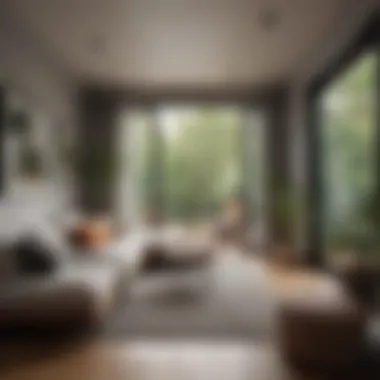

When one thinks about eco-friendly materials, the mind might wander to recycled paper or bamboo flooring. However, sustainable design encompasses a wide array of choices that can enhance the overall ambiance and reduce ecological footprint. For instance, using reclaimed wood not only adds character but reduces demand for new timber. Moreover, natural fabrics, such as organic cotton or linen, can be utilized for soft furnishings, contributing to indoor air quality as they are free from harmful chemicals.
Here are some key materials worth considering:
- Bamboo: Fast-growing and biodegradable, bamboo serves as a fantastic choice for furniture and accessories.
- Recycled Metal: Utilizing cast-off metal in furniture can offer a sturdy, industrial aesthetic without the guilt of new extraction.
- Low-VOC Paints: These paints ensure the air quality inside your apartment remains safe, avoiding the fumes associated with traditional paint.
- Natural Stone: When used sparingly, natural stone can lend an earthy appeal to kitchens and bathrooms.
Not only does thoughtful material selection minimize resource depletion, but it also elevates the living experience, turning a small apartment into a thoughtfully curated space. Design choices rooted in sustainability can make residents feel proud of their home, knowing they contribute to a healthier planet.
Reducing Footprint and Waste
Living in small spaces naturally encourages a minimalist lifestyle. However, it also presents a unique opportunity to consciously evaluate one’s consumption habits. By understanding the impact of daily choices, residents can significantly decrease their ecological footprint.
- Smart Shopping: Focus on purchasing items that are both essential and durable. Instead of opting for trendy decor that may get tossed after a season, invest in timeless pieces that possess quality craftsmanship.
- Composting: Even if kitchen space is tight, countertop compost containers can thrive in a small apartment. A composting approach not only reduces waste but also nurtures houseplants or window boxes.
- Thoughtful Waste Management: Take the time to sort waste properly, ensuring recyclables find their place in the correct bin. This small act can propagate better waste management habits and even inspire neighbors to follow suit.
- Digital Over Physical: Embrace technology to lessen physical clutter. Digital books, streaming services for entertainment, and online subscriptions can significantly cut down on physical items around the home.
"Every small action counts, and in a one-person apartment, the potential for impactful choices is magnified."
Adopting sustainable living practices isn't just about reducing waste; it's also about cultivating a lifestyle that appreciates simplicity. By integrating eco-friendly materials and minimizing waste, those living in small spaces can lead the charge in redefining modern living. In the end, it’s about creating a home where comfort aligns with responsibility – a truly rewarding endeavor.
Cultural Perspectives on Small Living
Understanding the cultural dynamics of small living spaces is essential for grasping how different societies approach housing, identity, and lifestyle. Cultural perspectives not only inform the design and functionality of one-person apartments but also reflect the underlying values and priorities of communities around the world. This section dives into two critical aspects of this topic: diverse housing norms across the globe and how individuals adapt their living conditions to fit local lifestyles and expectations.
Diverse Housing Norms Across the Globe
Housing norms vary widely from one country to another; what's common in one culture could be viewed as peculiar in another. For instance, in Japan, small apartments are a norm rather than an exception; urban living comes with space constraints, prompting a focus on efficient design. Homes are often compact, favoring vertical storage and multifunctional furniture. Classical Eastern philosophies also emphasize harmony and simplicity in living environments, aligning with the cultural respect for minimalism.
Consider in contrast, European cities like Paris where the petite studio apartments reflect a bohemian lifestyle. The allure of these cozy spaces combines ease of access to cultural hotspots with a semblance of intimacy. Here, the architecture often marries the past with modern comforts and aesthetics.
In the United States, on the other hand, one-person apartments can lean towards spacious layouts, reflecting a cultural preference for personal freedom and individual expression. Tiny homes movement, however, has made an exceptional impact, with small living spaces becoming trendy. They’re often associated with a sustainable lifestyle, appealing to those who seek to reduce their ecological footprint.
Small living isn’t just a physical state; it's a reflection of what we value in life—be it simplicity, intimacy, or freedom.
Adapting to Local Lifestyles and Expectations
Understanding local lifestyles is vital for anyone living in or designing small apartments. Cultural expectations shape how space is utilized, and individuals often find creative ways to meld their personal styles with local traditions.
For instance, in Nordic countries, practical designs that embrace natural light and open spaces are highly valued. Furniture tends to be minimal but stylish, creating a sense of openness that combats long, dark winters. Here, people prioritize practical use of space while ensuring comfort and warmth.
In places like India, small living spaces often open up to communal areas, allowing for a shared lifestyle. Gathering spots are crucial for socialization, so the interior design of one-person apartments often blends seamlessly with communal living.
Also, individuals moving to a new culture may face challenges, like adjusting their design aesthetics to fit in with the local style. A native of New York City may grapple with fitting stylish decor into a minimalist Tokyo studio that demands functionality over form. Thus,
- Respect for Local Norms: Understanding and embracing cultural aesthetics helps in achieving harmony in small living.
- Balancing Functionality with Expression: It’s essential to ascertain which aspects of one’s own style can be harmoniously integrated into the existing norms.
As we continue to explore these cultural dimensions, it becomes clear that the way people live is deeply intertwined with their cultural backgrounds. In a world where globalization is reshaping ideas about space and living, the nuances of these cultural perspectives will continue to play a critical role in shaping small living dynamics.
Closure: The Future of Small One-Person Apartments
As urban areas continue to grow and housing demands evolve, small one-person apartments stand out as a crucial solution to modern living challenges. These compact spaces not only reflect changing lifestyles but also offer a canvas for innovative design and efficient use of resources. The future of small one-person apartments is, therefore, not just about the reduction of space; it embodies a larger cultural shift towards minimalism, efficiency, and sustainability.
Evolving Urban Landscapes
Cities worldwide are transforming into dense hubs of activity, pushing the boundaries of traditional housing. As populations swell, small apartments are increasingly seen as a viable option for both new urban dwellers and those looking to downsize. The rise of remote work has also played a role. People aren’t confined to commuting to an office every day, leading many to seek out smaller, affordable living spaces that are closer to the amenities they value, such as cafes, parks, and coworking spaces.
Interestingly, this trend diverges from the past where larger homes were viewed as symbols of success. Today's urbanites often view space differently, valuing community engagement and accessibility over the sheer size of their living quarters. Furthermore, cities are introducing zoning reforms aimed at promoting the construction of micro-apartments. This can lead to denser populations without overwhelming resources, making urban living more sustainable and efficient.
Innovations on the Horizon
As the push for small living escalates, numerous innovations are on the rise. Technological advancements are set to reshape these compact environments. For instance, smart home gadgets that optimize energy use and enhance security are becoming the norm. Smart locks, automated lighting, and energy-efficient appliances provide convenience while reducing the ecological footprint.
Moreover, there’s a growing interest in space-saving furniture—pieces that fold, stack, or serve multiple purposes. Companies now prioritize multifunctional design elements, allowing individuals to adapt their living environments as their needs change.
Another exciting development lies in sustainable practices. The future of small one-person apartments will likely see a wider adoption of eco-friendly materials, recycling methods, and energy-efficient building techniques. These innovations not only make living spaces more liveable but also align with a broader ecological consciousness that more people are adopting.
"The future belongs to those who believe in the beauty of their dreams." - Eleanor Roosevelt
Safeguarding the nuances of one-person living while prioritizing comfort and style will continue to define the architecture and design of small apartments. As our urban landscapes shift and innovations emerge, embracing the dynamics of small apartments may very well lead the way towards a more sustainable, efficient, and community-driven future.





